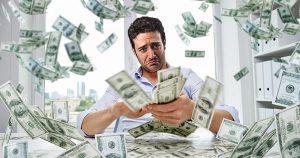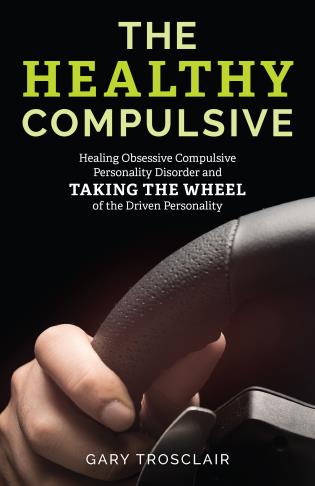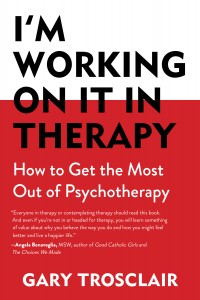Forty-eight hours ago, after a weekend of frantic formatting, I sent my editor the first draft of a book I’ve been working on for almost four years (more on that later). Has finishing it made me happier? Or has this been just one more of those carrots tantalizingly dangled in front of us as we pursue them on a compulsive hedonic treadmill of achievement followed quickly by depression?
This is the third in a short series of posts on depression and the compulsive personality. People who are driven or compulsive function in a number of ways that make us especially vulnerable to depression.
Compulsives may live on their own particular version of the Hedonic Treadmill. We imagine we’ll be happier by completing, perfecting, producing and fixing, and we’ll run like the devil to get to that make-believe paradise of bliss. But even when we do succeed in reaching any of these goals, the warm light of happiness does not shine on us eternally. In fact, we tend to plunge into darkness soon after.
Many people become depressed when they feel that despite achievements they have not been able to find sustainable happiness.
And, at least as importantly, crossing tasks off a list to ward off depression can prevent us from dealing with deeper issues that need our attention, issues such as coming to terms with loss and limitation. Like running from a ghost, just because depression doesn’t hold you fully in its grips doesn’t mean it doesn’t affect you.
Contents
The Hedonic Treadmill
The phrase Hedonic Treadmill refers to the tendency we all have to revert to a set level of happiness or unhappiness after experiencing events that we expected to make us happier. The term “hedonic” refers to sensations that are pleasurable. You’re already painfully aware of what the treadmill refers to–boring repetition. Thus certain forms of pleasure become boring and unpleasant when you’re on the Hedonic Treadmill.
Our overall mood doesn’t change much over time because we tend to return to pretty much the same level of happiness a few months after even major positive or negative events or life changes–unless we bring conscious intention to our own personal treadmill, which we’ll get to later.
In a classic study researcher Philip Brickman and his colleagues found that people who won the lottery were not any happier three months after winning than they were before, and people who became paraplegic were about as happy after losing their abilities as they had been before.
Been There Done That
Brickman believed that we adapt to our circumstances. When we experience something really great or horrifically bad, things that feel merely pretty good or merely sort of bad hardly register after that. So, after you’ve won a million dollars, finding a $20 on the street doesn’t do much for you, whereas before it might have made your day.
The human psyche responds more to change than to static circumstances. What seems great at first feels about as exciting as flossing after a while. So, according to this line of thinking, trying to become happier is doomed to failure. You’re right back on that boring treadmill again.
It turns out that while there is some truth to this, it’s not as simple, dire or unalterable as things looked at first. According to research published in The American Psychologist, set points determining mood can change under some conditions.
Two Types of Happiness
Richard Davidson, a scientist at the University of Wisconsin, has conducted research which indicates that there are two sorts of happiness: a short-lived form of happiness that we experience upon completing a goal (like the deep satisfaction that compulsives experience when crossing things off a list), and a longer-lasting happiness that we can experience as we move toward a goal. These two sorts of happiness involve different parts of the brain, different hormones, and different rates of customer satisfaction.
The Compulsive Version of the Hedonic Treadmill
Compulsives imagine that the first sort of happiness, the kind we experience in completing tasks, getting things organized, fixing problems and perfecting things, will make us feel happier. We may focus so intently on completion that we miss the possibility of the second sort of happiness, the more lasting kind that we get from being engaged in a project and savoring the challenge.
Unhealthy compulsives tend to rush from one goal to the other and never experience lasting happiness. Healthy compulsive enjoy the drive.
Ironically, the process of engaging in any of these activities can make us happier; but the completion of them only makes us happy for a short time.
Compulsives are in the gifted and talented class when it comes to delaying gratification. We tend to think that once we get something done, we’ll feel better, so we tolerate stress and endure pain to get there. (You can find more about this in a post I did about Gratification, on April 30, 2023 in which I describe four different types of gratification and our need for each of them. So far it’s just in the blog but I’ll eventually record it and put it up on the podcast.)
Certainly there are times when we do need to grit our teeth and power through with determination, knowing that it needs to be done and that we’ll grow through it.
But to constantly prioritize the completion of goals keeps us on the compulsive Hedonic Treadmill. And that can bring on depression, or keep us from dealing with an underlying depression.
So, at the risk of repeating what you’ve probably heard already, but have completely ignored because you thought it was soft, trite and sentimental: if you can enjoy your projects as you work on them, you’re more likely to be happy than if you keep trying to get them over with.
Evolution’s Short-lived Reward for Getting Stuff Done
As I wrote in my previous post on depression, we’re programmed to feel pleasure for things that made us more likely to pass on our genes in the environment that we evolved in. Sex is usually good for that. And sugar used to be good for that too because it gave us energy and wasn’t so ubiquitously available. So we still find them pleasurable, whether they’re still really helpful or not.
There are some variations among us, depending on what genes we’ve gotten, but people who are driven usually find pleasure in organizing, planning, correcting, perfecting, and fixing. These have helped us to survive and adapt. We get a subtle hit of pleasurable hormones in the left side of the brain as we’re doing it. This is a sustainable pleasure. 
But then, once we check off the box or cross tasks off our list, we experience a brief period of pleasure originating on the right side of the brain caused by a release of different hormones. It can’t last for long, otherwise we wouldn’t get anything else done.
But since it doesn’t last for long, you scan your world for what else needs to be organized, planned, corrected, perfected or fixed. Otherwise you might feel that depression you’ve been trying to avoid.
Achieving to Avoid Depression
Writers, for instance, typically experience some relief at completing an article or book, but depression often comes quickly after. So we start another piece to stave off depression.
Any of you who have read William Styron’s Darkness Visible may remember how depressed he became after finishing a book.
Despite this inevitable let down, if we need to have evidence of our worth, we may come to rely on completion rather than process, and we slide from the healthy end of the compulsive spectrum to the unhealthy end of the spectrum. In doing so we exchange intrinsic motivation for extrinsic motivation; we work because we think it looks good on us, rather than feeling good inside. Depression ensues.
Even so, this can still be addictive.
Addiction to achievement

Some people deal with insecurity by consuming luxury items to prove to others that they have status, thinking that will make them happy. But it doesn’t.
Compulsives try to deal with insecurity and prove their status by achieving perfection or achievement rather than collecting material goods. But it doesn’t solve the underlying problem of insecurity.
Rather than developing a sense of basic self-acceptance, we seek more achievement and an addictive cycle of short-lived relief ensues. As with addiction, we need more and more achievement to simply avoid the painful feelings of withdrawal and depression.
Stepping Off the Treadmill By Savoring Process
To step off the Hedonic Treadmill we need to become aware of what we usually think will make us happy and question it.
If you’re driven, compulsive or type A you probably won’t be able to stop fixing and planning and producing completely, but you can choose whether you invest consciously in savoring them or just getting them over with.
While the satisfaction of major achievements may not take us off the Hedonic Treadmill, the consistent practice of incremental change does seem to help us get off of it and feel a more enduring, albeit measured, happiness. And, it prevents depression.
So, right now:
- Try to notice if you lean forward in your body toward some more completed future.
- Try to notice what the motivation underneath that urge is.
- Substitute appreciation of the present moment and its challenge for future completion. What can you savor about the projects that you’re engaged in now?
Turning in that book draft to my editor did make me happy–for a little while. But the more sustainable happiness comes with the writing itself. So here I am putting words together again, trying to be with it rather than trying to get it finished. And that makes me happy.
To keep getting the latest insights and inspiration from The Healthy Compulsive Project, press the subscribe button below, type in your email address, and you’ll get a notice whenever a new post comes out.





4 Comments
Leave your reply.